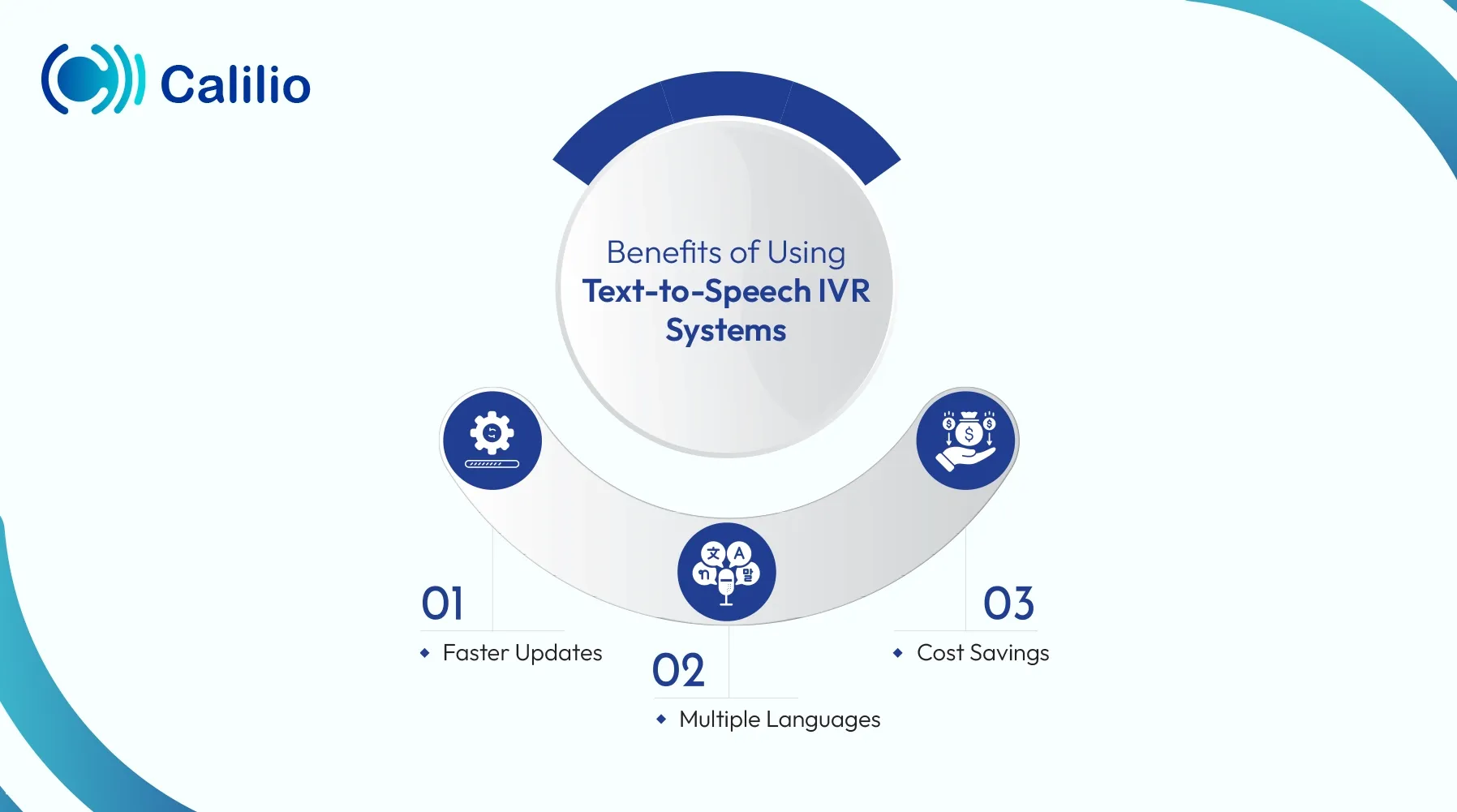Text-to-Speech IVR: What It Is, How It Works, and Key Benefits

Tired of re-recording your IVR messages every time something changes, be it new offers, menu updates, or just a shift in business hours? It’s time-consuming, costly, and frustrating, especially when you're relying on voice artists or studio sessions.
That’s where Text-to-Speech (TTS) IVR comes in. Instead of relying on recorded prompts, TTS IVR turns written text into clear, natural-sounding voice prompts in real time. You can update messages instantly, support multiple languages, and personalize interactions, all without extra recording costs.
In this guide, you’ll learn what TTS IVR is, how it works, and why more businesses are replacing traditional IVR with faster, smarter voice automation.
Highlights:
What Is Text-to-Speech IVR?
Text-to-speech IVR is a type of automated IVR (Interactive Voice Response) system that converts written text into spoken words to deliver personalized messages to callers in real-time.
Instead of manually recording prompts, the TTS engine, powered by AI voice technology, allows the IVR to generate clear, natural-sounding voice messages dynamically. This eliminates the need for a studio or a voice artist.
You can adjust the language, tone, voice, gender, accent, and pitch of the speech to match your brand or audience, making it ideal for delivering a conversational IVR experience. It’s used in call centers and customer service systems to provide automated voice responses to callers based on their input or queries.
How Does Text-to-Speech IVR Work?
When a customer calls, a TTS IVR checks what message to play, converts text into speech, and plays it instantly.
- Call Initiation: Initially, the customer calls your IVR platform.
- Greetings: The IVR system automatically answers the calls and greets the customer with AI-generated voice prompts.
- Options and Selection: The IVR system converts written scripts into voice prompts, allowing the customer to hear the options and select their choice using the keypad (DTMF, Dual Tone Multi-Frequency) or voice commands, depending on the IVR setup.
- Call Routing: Based on the caller’s selection, the system routes the call to the appropriate department or provides further instructions.
Benefits of Using Text-to-Speech IVR Systems
TTS IVR makes it easy to update messages, offer multiple voice prompts to callers, personalize calls, and cut costs.

- Faster updates: You can change old messages in your IVR system anytime by typing new text. There’s no need to record fresh audio each time, schedule recordings, or hire someone to read the script.
- Multiple languages: It’s easy to serve customers who speak different languages since you don’t need separate voice actors for each one.
- Cost savings: You save money on recording sessions, editing, and hiring voice actors. Once set up, changes only take a few minutes and don’t cost extra.
How to Set up Speech-enabled IVR?
To set up an IVR with text-to-speech features, choose a provider, pick a natural voice, and write clear, concise prompts. Afterwards, test pronunciation, set up your call flow, and go live, then monitor and refine as needed.
- Choose an IVR provider: Pick a reliable phone system that supports text-to-speech.
- Select your voice: Pick a voice and language that fits your brand.
- Write your prompts: Create short, clear messages for each menu option.
- Test the pronunciation: Check how the TTS engine reads names, numbers, and special terms using natural language processing features. Adjust if needed.
- Set up call flows: Arrange your menu structure so callers reach the right team quickly.
- Go live and monitor: Launch your IVR, listen to calls, and make updates in prompts when needed.
Skip the Recordings — Update Your IVR Menu Instantly with Calilio
Convert text into multilingual voice prompts instantly. No voice actors, no recordings, just streamlined automation.
Best Practices for Setting up TTS IVR
Some best practices you can observe while setting up a dynamic IVR are to ensure you keep your prompts clear and concise, and choose the natural voice option.

- Keep prompts short and clear: Use simple words and short sentences to improve the caller experience and reduce confusion.
- Choose natural-sounding voices: Pick a voice that matches your brand and feels human and natural.
- Test pronunciation: Check that names, numbers, and special terms sound right. Adjust spelling if needed for correct reading.
- Combine with touch-tone options: Offer both DTMF and voice command options to ensure a conversational IVR system that meets diverse preferences.
Conclusion
Text-to-speech IVR makes automated phone systems smarter and easier to manage. It turns text into clear voice prompts, updates messages instantly, supports many languages, and lowers costs. Unlike old pre-recorded menus, you can change information anytime without delays.

Get Cashbacks Up to 43% Straight To Your Wallet!
Unlimited Virtual Numbers – Local, Mobile & Toll-Free from 100+ Countries
Free Local Phone Number from US or Canada
Crystal-Clear Calls Starting at Just $0.0153/min
24/7 Human Support – Because Great Service Never Takes a Holiday


Frequently Asked Questions
What is text-to-speech IVR?
Text-to-speech IVR is a phone menu system that uses text-to-speech technology to read written text as spoken voice. It lets businesses update messages instantly without recording new audio.
How does TTS IVR help businesses?
Is text-to-speech IVR secure?
Can I add multiple languages to my IVR system?

Still have questions?
Can’t find the answer you’re looking for? Please chat with our friendly team.
Stay in the loop
Get the latest call insights, trends, and updates delivered straight to your inbox.
By subscribing, you agree to receive updates from Calilio.
You can unsubscribe anytime.